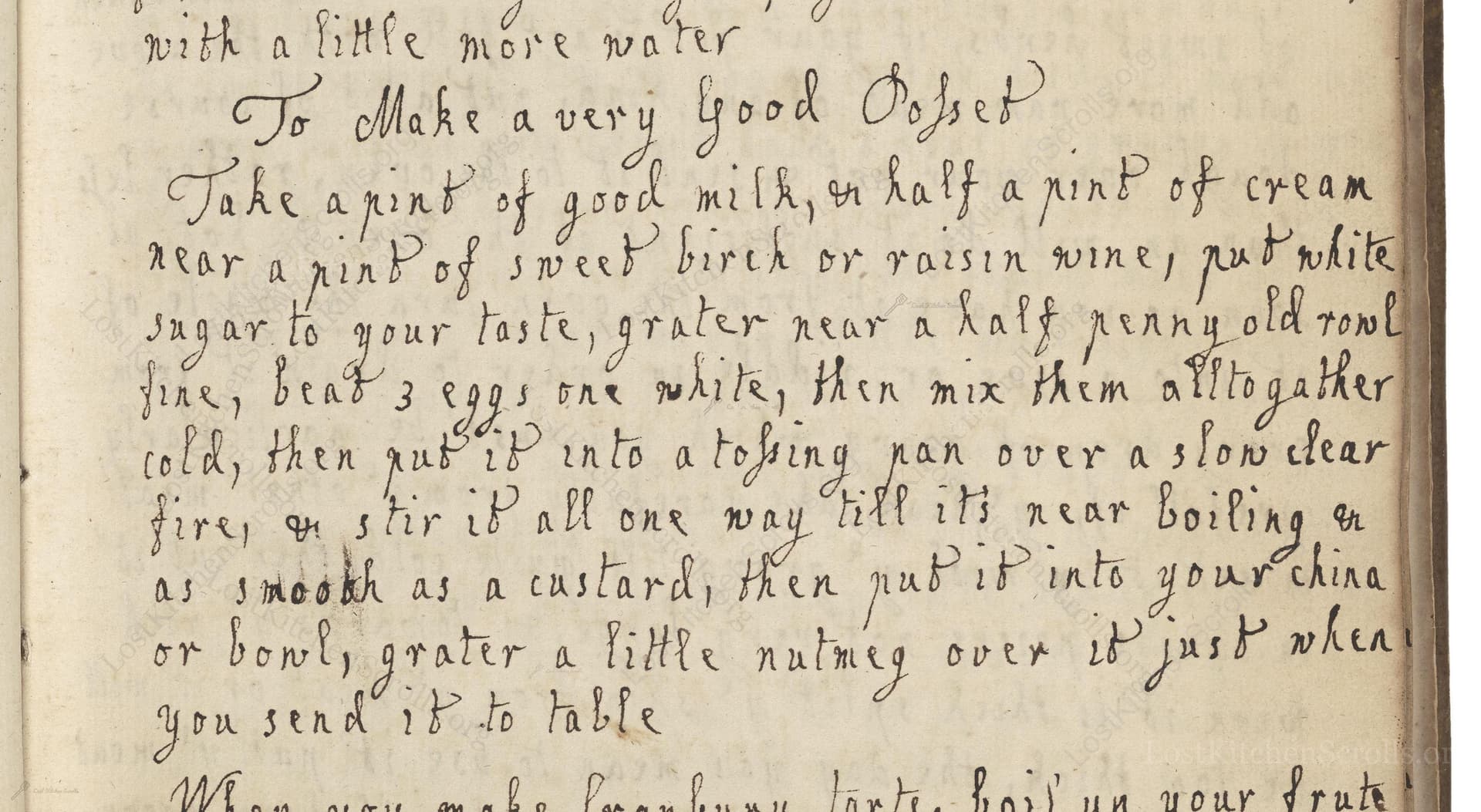To Make A Very Good Posset
From the treasured pages of Cookbook of 1720
Unknown Author

To Make A Very Good Posset
"Take a pint of good milk, or half a pint of cream near a pint of sweet birch or raisin wine, put white sugar to your taste, grater near a half penny old rowl fine, beat 3 eggs one white, then mix them all together cold, then put it into a tosing pan over a slow clear fire, or stir it all one way till its near boiling or as smooth as a custard, then put it into your china or bowl, grater a little nutmeg over it just when you send it to table"
Note on the Original Text
The recipe is written in the direct, unpunctuated style of early 18th-century English cookery books: ingredients and instructions are interwoven in a single paragraph, with little separation between steps. Measurements are approximate, using everyday objects (e.g., 'pint', 'half penny old rowl') rather than standardized weights. Spelling follows older conventions—'tosing pan' for 'tossing pan', 'rowl' for 'roll' (bread roll). Cooks of the day were expected to adapt instructions to the context and ingredient availability, relying on prior knowledge and experience to achieve the desired result.

Title
Cookbook of 1720 (1720)
You can also click the book image above to peruse the original tome
Writer
Unknown
Era
1720
Publisher
Unknown
Background
Step back to the early 18th century and discover a delightful treasury of recipes and culinary secrets, where traditional flavors meet timeless technique—a feast for curious cooks and history lovers alike.
Kindly made available by
Folger Shakespeare Library
This recipe for a posset comes from around 1720, a time when possets were transitioning from their medieval medicinal roots towards becoming indulgent, custard-like desserts enjoyed at the table. Originally, possets were made by curdling hot milk with wine or ale and were believed to have restorative properties, often used as remedies for colds or sleeplessness. By the early 18th century, recipes such as this one had evolved to incorporate eggs and bread, resulting in a luxurious, smooth concoction more akin to custard than the original lumpy brew. The inclusion of birch or raisin wine, both popular choices for flavor and sweetness in the period, reflects the Georgian taste for aromatic, enriched desserts.

In the 1720s, cooks would use a 'tossing pan' or small saucepan, ideally of copper or pewter lined with tin, to gently heat and stir the posset. A hand whisk or wooden spoon would be used to beat the eggs and continuously stir the mixture to ensure smoothness and prevent curdling. The final posset would be poured into a communal bowl or individual china cups for serving, showcasing both the cook's skill and the household's fine tableware. A nutmeg grater, a prized kitchen tool of the era, would provide the essential finishing touch.
Prep Time
10 mins
Cook Time
15 mins
Servings
4
We've done our best to adapt this historical recipe for modern kitchens, but some details may still need refinement. We warmly welcome feedback from fellow cooks and culinary historians — your insights support the entire community!
Ingredients
- 2 cups whole milk or 1 cup double (heavy) cream
- 1 2/3 cups sweet birch wine (or substitute with sweet raisin wine or muscatel)
- 2-3 tablespoons (1-1.25 ounces) white granulated sugar (to taste)
- 0.5 ounce stale sweet bread or roll, finely grated
- 2 large eggs plus 1 egg white
- Fresh nutmeg, for grating at service
Instructions
- Begin by measuring out 2 cups of whole milk or, for extra richness, 1 cup of double (heavy) cream.
- To this, add approximately 1 2/3 cups of a sweet white wine such as birch wine (or a good quality sweet raisin wine or muscat as a substitute).
- Sweeten to taste with 2-3 tablespoons (about 1-1.25 ounces) of white sugar.
- Grate the end piece of a stale sweet bread roll (about 0.5 ounce) to use as a thickener, much like a roux or fine breadcrumbs.
- Beat 2 large eggs plus 1 egg white together until combined.
- Mix all these ingredients together in a cold saucepan.
- Slowly heat over low flame, stirring constantly in one direction, until the mixture thickens just before boiling—aim for the consistency of custard (160–175°F).
- Pour into a heatproof serving bowl or individual dishes.
- Finish with a grating of fresh nutmeg just before serving.
Estimated Calories
270 per serving
Cooking Estimates
Preparing this custard-like dessert takes about 10 minutes to gather and measure the ingredients, and around 15 minutes to slowly cook and thicken the mixture. Each serving contains about 270 calories, and the recipe makes about 4 servings.
As noted above, we have made our best effort to translate and adapt this historical recipe for modern kitchens, taking into account ingredients nowadays, cooking techniques, measurements, and so on. However, historical recipes often contain assumptions that require interpretation.
We'd love for anyone to help improve these adaptations. Community contributions are highly welcome. If you have suggestions, corrections, or cooking tips based on your experience with this recipe, please share them below.
Join the Discussion
Rate This Recipe

Den Bockfisch In Einer Fleisch Suppen Zu Kochen
This recipe hails from a German manuscript cookbook compiled in 1696, a time whe...

Die Grieß Nudlen Zumachen
This recipe comes from a rather mysterious manuscript cookbook, penned anonymous...

Ein Boudain
This recipe comes from an anonymous German-language manuscript cookbook from 169...

Ein Gesaltzen Citroni
This recipe, dating from 1696, comes from an extensive anonymous German cookbook...
Browse our complete collection of time-honored recipes



